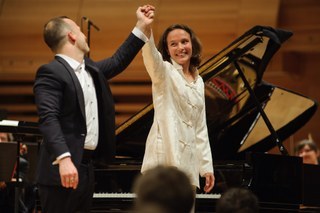|
Back
Montreal Concert Misses the Mark Montreal
Maison symphonique de Montréal, Place des Arts
06/12/2014 - & June 13, 2014
Johannes Brahms: Piano Concerto No. 1 in D minor, Op. 15
Anton Bruckner: Symphony No. 3 in D minor (1873 Version, Nowak)
Hélène Grimaud (piano)
Orchestre Métropolitain, Yannick Nézet-Séguin (conductor)

Y. Nézet-Séguin & H. Grimaud (Courtesy of O.M.)
Despite two big Romantic works, a renowned pianist, an augmented orchestra and an adorning audience, Orchestre Métropolitain’s concert on June 12 never took flight.
Montreal’s “second orchestra”, led by Principal Conductor Yannick Nézet-Séguin, opened the evening with Brahms’s Piano Concerto No. 1. Soloist Hélène Grimaud, who didn't impress during her last concert here in 2011, failed to bring depth and passion to this monumental work. Her playing lacked direction and focus, and didn’t coalesce with that of the orchestra. The first movement, thought to be inspired by the shocking news of Robert Schumann’s attempted suicide by drowning, had a few dramatic moments, as in the sections with double octaves. It suffered, however, from muddy articulation and over-pedaling, as well as an unconvincing dialogue with the orchestra. The Adagio, which some believe is a love song to Clara Schumann, lacked a unifying musical line. Although Grimaud showed adequate technique and respect for Brahms’s dynamic markings, one wondered “Does she love this music?” The last movement was replete with the required pyrotechnics but, except briefly before the cadenza, without excitement.
The concert concluded with Bruckner’s Symphony No. 3, sometimes referred to as the "Wagner Symphony", as it was Wagner’s choice of two early symphonies Brahms offered him for dedication. In remarks from the stage, Nézet-Séguin noted that he chose the earliest and longest version (there are at least six) because at approximately 68 minutes, it had 10 minutes more music (ha ha), and also because of the interesting allusions to the music of Wagner. These were cut from the later versions.
Nézet-Séguin and his orchestra failed to deliver a gripping performance. The sound, unlike that of the Brahms, was clean and bright, and sectional playing was tight and convincing, especially the strings and the brass. But there was little tension to the music and one could feel there was no bond between the orchestra and the audience.
Nézet-Séguin has a particular love for Bruckner, and this work was being recorded for release in the fall. He has already recorded several of his symphonies with this orchestra, and he is probably contemplating a complete set.
Normally, Nézet-Séguin delivers electrifying performances with whatever orchestra he is conducting, but sometimes there is, as on this occasion, an off night. I last saw him conduct in Berlin this past winter, where he led the Berlin Philharmonic in a sublime Mahler Fourth. A trusted colleague there said that he is the front-runner to replace Sir Simon Rattle when his contract ends in 2018. I’m keeping my fingers crossed.
Earl Arthur Love
|